nForce4 SLI Motherboards: Premium Performance at a Bargain Price
by Gary Key on January 3, 2006 12:05 AM EST- Posted in
- Motherboards
ASUS A8N-SLI Premium: Features
Asus has engineered a very effective cooling system that utilizes a small heat sink attached to a heat pipe that comes in direct contact with the nForce4-SLI chipset. This system then transfers the heat to a finned heat sink that also cools the MOSFETs. The whole system is fanless, but relies on the exhaust air generated by the CPU heat sink fan to cool the finned heat sink. We would recommend that a fan be placed on or near this heat sink when water or phase change cooling systems are utilized.
The Silicon Image 3114R SATA II RAID (red) ports are located to the left of the CK8-04 chipset and above the nForce4 SATA II ports. The SATA II ports feature the old attachment design that could create connection issues.
The nForce4 USB connectors, IEEE1394a connector, Com1 serial port, and System Panel connector are located along the left edge of the board. The CMOS reset is a traditional jumper design located between the battery and Super I/O chipset that proved to be inconvenient at times.
However, in between the two x16 PCI Express slots are the two PCI-E slots. This configuration could potentially render the PCI-E x1 slot useless when utilizing the first x16 PCI Express slot. The amount of space in-between the two PCI-E x16 slots is excellent and allows for a two-slot or third party video card cooling solution to be utilized. The first PCI slot next to the second PCI-E x16 slot will be rendered useless when utilizing a two-slot video card cooling solution.
The finned heat sink, which cools the MOSFETs and is part of the heat pipe system, is visible along with the 4-pin 12V molex connector next to the PCI-E x16 slot. The molex connector is required when utilizing two video cards in SLI operation.
Asus places the four-pin 12V auxiliary power connector at the top of the CPU socket area, but out of the way of most aftermarket cooling solutions.

Asus has engineered a very effective cooling system that utilizes a small heat sink attached to a heat pipe that comes in direct contact with the nForce4-SLI chipset. This system then transfers the heat to a finned heat sink that also cools the MOSFETs. The whole system is fanless, but relies on the exhaust air generated by the CPU heat sink fan to cool the finned heat sink. We would recommend that a fan be placed on or near this heat sink when water or phase change cooling systems are utilized.
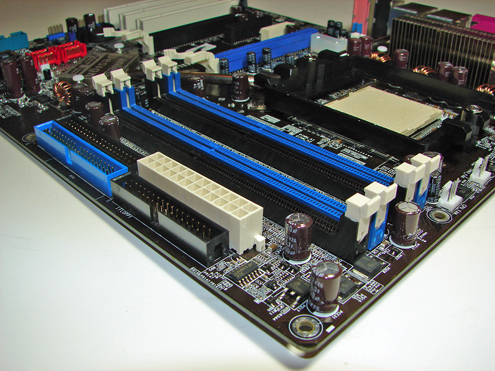
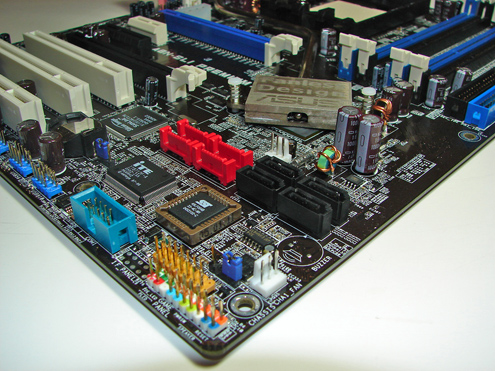
The Silicon Image 3114R SATA II RAID (red) ports are located to the left of the CK8-04 chipset and above the nForce4 SATA II ports. The SATA II ports feature the old attachment design that could create connection issues.
The nForce4 USB connectors, IEEE1394a connector, Com1 serial port, and System Panel connector are located along the left edge of the board. The CMOS reset is a traditional jumper design located between the battery and Super I/O chipset that proved to be inconvenient at times.
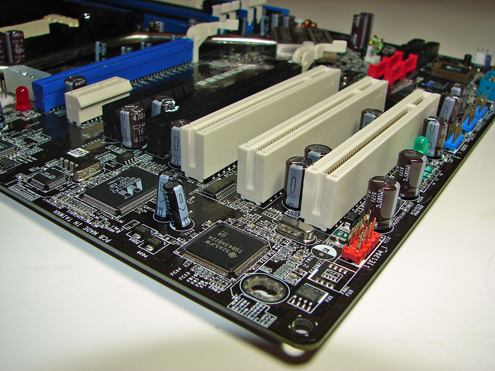
However, in between the two x16 PCI Express slots are the two PCI-E slots. This configuration could potentially render the PCI-E x1 slot useless when utilizing the first x16 PCI Express slot. The amount of space in-between the two PCI-E x16 slots is excellent and allows for a two-slot or third party video card cooling solution to be utilized. The first PCI slot next to the second PCI-E x16 slot will be rendered useless when utilizing a two-slot video card cooling solution.
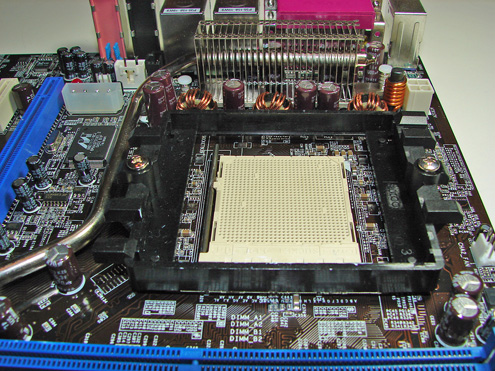
The finned heat sink, which cools the MOSFETs and is part of the heat pipe system, is visible along with the 4-pin 12V molex connector next to the PCI-E x16 slot. The molex connector is required when utilizing two video cards in SLI operation.
Asus places the four-pin 12V auxiliary power connector at the top of the CPU socket area, but out of the way of most aftermarket cooling solutions.
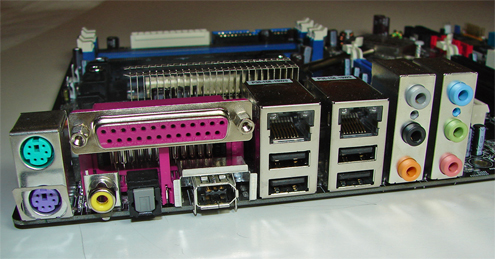










37 Comments
View All Comments
Gary Key - Tuesday, January 3, 2006 - link
Corrected. I apologize for that error and the previous mention of DDR2 in the Asus memory section. My right side brain was thinking DDR but the Intel side of the brain was typing DDR2. ;->
JarredWalton - Tuesday, January 3, 2006 - link
Nah, these are M2! Seriously, though, thanks - busted Gary on the copy/paste, eh? Although he did get the memory speeds right, so you can't go too hard on him. :)Martrox - Tuesday, January 3, 2006 - link
I've got a K8SLi that I picked up for $80. I'm currently running a 3000+ Venice at 2610(9x290) memory set to 166fsb(TCCD 2x512)2.5,3,3,7. Running 7800GT's SLi'ed with absolutely no problems.......Wish the voltage options were better, but it does work pretty well.lopri - Tuesday, January 3, 2006 - link
The title says, and the article begins with "Premium performance at bargain price" then it ended up praising (and recommending) ASUS board. The ASUS board doesn't belong to same ground as that of the other two boards, and the price of the board certainly proves it. In the first page how affordable NF4-SLI boards have become is mentioned ($70), then compare 2 value boards with a premium board($170)? What's the point of this review? Did ASUS ask to boost the "A8N-SLI Premium" board since they can't meet the demand of "A8N32-SLI"?I'm sorry but as an avid AT reader/forumer, I should say this review is totally off. It's nothing but an ASUS PR presentation. Also, it's been pointed out many times lately, but according to AT reviews, every single board on the market is a "great overclocker," "dark-horse," "keeper," "enthusiast-targeted". Everytime AT reviews a motherboard they miraculously find something to compliment and that becomes the main point of the article.
It's almost up to the point that I no longer completely trust AT motherboard reviews. I'm sorry to say this, especially the author of this specific article, but my comment is more general towards the whole AT motherboard team. (Wesley, Jared, et. al)
Is this going to continue? (Sigh..)
JarredWalton - Tuesday, January 3, 2006 - link
Just curious, Lopri, but you did notice that the Foxconn and Albatron received a recommendation based on price, right? There are people that want all the features of something like the ASUS Premium, and they're willing to pay for it. All three motherboards here are pretty decent, though, and while I didn't write the article I'm a little confused as to how this is seen as a PR piece.To a certain extent, all reviews are a form of PR. Companies send us a product and we review it. We review other products sometimes, but generally speaking we review the products that we get sent. The only things that really separates these boards from each other are features and overclocking capability. In most of the benchmarks, scores are close enough that you needn't lose sleep over the difference.
Wesley Fink - Tuesday, January 3, 2006 - link
We've complained plenty about the ATI SB450 southbrudge (poor USB 2.0 performance) even though we like the ATI chipset in general. We've also complained loudly about nVidia's mediocre AC'97 audio on their top boards when ATI and ULi are delivering hooks for HD Azalia in their AMD chipsets.Frankly, until very recently Asus had not had a really great AMD board since the Socket A days - they hadn't won a single AMD roundup in quite a while. Asus rested on really great Intel boards. Recently Asus got very serious about the AMD market and the A8N32-SLI Deluxe is a great board. So is the A8R-MVP at the price point of around $100. However, as another recent review clearly showed, the Asus 6150 is pretty pedestrian and not a great choice for a multimedia PC with all the important multimedia stuff an extra cost option.
A lot of the real crap boards we see get pulled from the market before release and our review never sees the light of day. An example is the original Asus Premium reviewed here, which was a terrible overclocker due to the switches that replaced the paddle for SLI switching. When we complained to Asus they decided to hold off release of the board and rework the switching. The result is the board reviewed here which is a huge improvement. Oddly, it overclocks FSB very well but really does not do a great job in overclocking memory. The A8N32-SLI Deluxe is still the better board for the Enthusiast.
The motherboard team really cares about the products, and they aren't looking for a sensational story like some other sites. We could write Inquirer-like exposes on plenty of the early BIOS' we receive, but we prefer to work with the manufacturer to try to resolve the issues on production boards. If we can't get things to work we ask lots of questions before we assume we are Gods and the board is junk. But if it's junk or just all hype in the end, we'll tell you that.
We began testing features more in-depth because the memory controller on the AMD CPU greatly reduced the performance variations we used to see in motherboards. Also most manufacturers have gotten more serious about going after the Enthusiast who is our basic reader. That's the reason you're seeing so many really good overclockers these days. Just when we think it can't get any better another board sets some new record. However there are lots of boards out there below these standards, and we do tell you that when we review them.
mindless1 - Tuesday, January 3, 2006 - link
I see nothing wrong with this concept, makes plenty of sense.I would not however consider this to be "Premium Performance at a Bargain Price". Back in the socket A days an AMD platform at a bargin price was $50-70 for your basic nForce2, of course a little higher when first deputed. It's very hard to make an argument that any board over $100 is bargain in this age with so many of the features chipset-integral.
If anything, the typical trends of motherboard features and performance are still holding true but at a far worse bargain than ever before. SLI should not cost much more except for the smaller market segment.
On a side note- Cooling the Asus board by moving the heat from the southbridge to the hottest zone on the board just to save a fan is a really bad idea. Almost seems like an afterthought for marketing purposes. Given the space that thing takes up they should've just use a giant low-profile passive 'sink if they really needed to stay fanless.
mindless1 - Tuesday, January 3, 2006 - link
"... by moving the heat from the southbridge"I too would like an edit function. ;-)
Beenthere - Tuesday, January 3, 2006 - link
...Mobo for the vast majority of PC users as the article states. Most people have no need or use for SLI and have no interest in paying a premium price for SLI when they will never use it. SLI is a gimmick for gamers and nothing more. If you want it, buy it, but I highly doubt mainstream PC users will cough up $170 bucks or more for SLI when you can have Asus's A8R-MVP Crossfire Mobo for $101. from Mwave.The $70. you save could go toward a nice Vid card and the A8R-MVP overclocks every bit as good as the SLI boards and performs better than all of the SLI Mobos per Wesley Finks recent review.
http://www.anandtech.com/mb/showdoc.aspx?i=2617">http://www.anandtech.com/mb/showdoc.aspx?i=2617
At $101. mainstream PC users can have the best performance, overclocking and not even worry about paying a premium for Crossfire or dual graphics cards. If in the future they really desire to blow more dough on a second video card, they could, but there would not be a price penalty for purchasing the superior A8R-MVP Mobo like there is with any of the SLI rigs.
Some1ne - Wednesday, January 4, 2006 - link
I agree, I feel that the article makes some unfounded and moreover highly irresponsible statements, such as "in fact, the current price structure almost ensures that your nForce4 purchase should be an SLI-capable motherboard." SLI is not worth it in any way, shape, or form from any cost/performance standpoint, unless you happen to be the enthusiast user who wants the highest possible performance available today no matter the cost. For everyone else SLI is worthess...and yet how many new users are going to go out and waste their cash on an SLI board because of statements made in the article like the one above?Irresponsible, and not backed up by any solid evidence. It's like the author started off with the assumption that SLI = good, so therefore any affordable SLI board is also good. It doesn't work like that though.